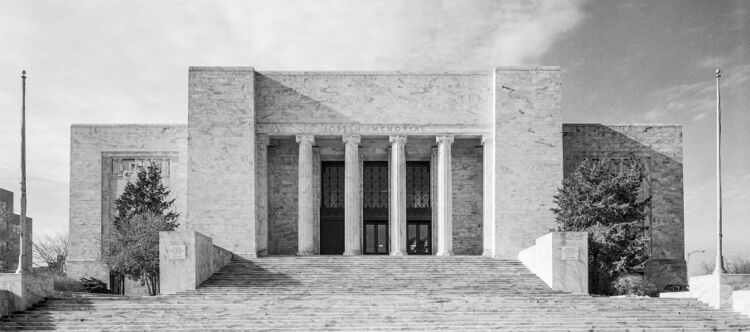Difference between revisions of "John & Alan McDonald, Architects"
m (→Undated) |
m (→Dated) |
||
| Line 54: | Line 54: | ||
Dundee Theater (1925), 4952 Dodge, Omaha, Nebraska.[[#References|[3:115][5]]] (DO09:0433-002) | Dundee Theater (1925), 4952 Dodge, Omaha, Nebraska.[[#References|[3:115][5]]] (DO09:0433-002) | ||
| − | Benson High School (1926), Omaha, Nebraska. [ | + | Benson High School (1926), 52nd & Maple St., Omaha, Nebraska.[[#References|[9:76]]] |
Peterson Baking Company Building (1927), 1120 Jones, Omaha, Nebraska.[[#References|[4]]] (DO09:0121-077) | Peterson Baking Company Building (1927), 1120 Jones, Omaha, Nebraska.[[#References|[4]]] (DO09:0121-077) | ||
| Line 71: | Line 71: | ||
The University of Omaha 1st classroom facility (1931), 24th & Pratt St., Omaha, Nebraska.[[#References|[9:58]]] | The University of Omaha 1st classroom facility (1931), 24th & Pratt St., Omaha, Nebraska.[[#References|[9:58]]] | ||
| + | |||
| + | Monroe Junior High School (1936), 5105 Bedford Ave., Omaha, Nebraska.[[#References|[9:77]]] | ||
Beth-El Synagogue (1940), 210 S 49th St, Omaha.[[#References|[3:101][5]]] (DO09:0431-001) | Beth-El Synagogue (1940), 210 S 49th St, Omaha.[[#References|[3:101][5]]] (DO09:0431-001) | ||
Revision as of 12:41, 26 January 2017
Partners:
John McDonald, Omaha, Nebraska
Alan McDonald, Omaha, Nebraska
John & Alan McDonald was an architectural firm that was in business for nearly thirty years. They designed a wide range of buildings.
This page is a contribution to the publication, Place Makers of Nebraska: The Architects. See the format and contents page for more information on the compilation and page organization.
Contents
Compiled Nebraska Directory Listings
Omaha, Nebraska, 1918, 1921-1925, 1926-1947
Other Associations
1929-1948: employed Robert Christian Robinson.
Buildings & Projects
Dated
Benson High School (1913), 5148 Maple, Omaha.[3:143][5] (DO09:0447-001)
Franklin Carnegie Library (1915-1916), 1401 L, Franklin, Nebraska.[1] (FR03-046)
Old People’s Home (later The Fontenelle Home, and later again, the Leo Vaughn Home) (1917), 3325 Fontenelle Blvd., Omaha.[4][5][9:56] (DO09:0338-003) National Register narrative
Ware Block (1918), 15th & Farnam, Omaha, Nebraska.[7]
Nebraska Capital Competition (1919), Lincoln, Nebraska.[2][9:18]
Walter Anderson House (1919), 1014 S 36th St, Omaha, Nebraska.[3:98][5] (DO09:0315-011)
The Hill Hotel (1919), 501 S. 16th St, Omaha, Nebraska.[3:49][4][5][9:66 (DO09:0121-011) National Register narrative
Commercial Building (1919), 2409 Farnam St., Omaha. (DO09:0209-043)
Standard Oil Co. Building (1919-1922), 500 S. 18th, Omaha, Nebraska.[4][5][9:64] (DO09:0122-001) National Register narrative
Medical Arts Building (1920), 105 S 17th, Omaha, Nebraska.[3:50][8][a]
Duplex (1921), 134-36 N. 38th St., Omaha, Nebraska.[5] (DO09:0321-041)
Standard Oil Red Crown Service Station (1922), 220 N Spruce, Ogallala, Nebraska. (KH04-053) National Register narrative
Elks Club Lodge (1923), 108 S 18th St, Omaha, Nebraska.[3:50][9:65] (DO09:0124-026)
Fairmont Foods (1923), 705 S. 12th, Omaha, Nebraska.[4] (DO09:0121-083)
Dundee Theater (1925), 4952 Dodge, Omaha, Nebraska.[3:115][5] (DO09:0433-002)
Benson High School (1926), 52nd & Maple St., Omaha, Nebraska.[9:76]
Peterson Baking Company Building (1927), 1120 Jones, Omaha, Nebraska.[4] (DO09:0121-077)
Society of Liberal Arts Bldg (1928), 2218 Dodge, Omaha, Nebraska.[3:114]
Dr. J.F. Langdon House (1928), 503 N. 38th St., Omaha, Nebraska.[5][8:42] (DO09:0323-015)
Patterson Building remodel (1928), 17th & Farnam St., Omaha, Nebraska.[9:72]
Dormatories (1930), Nebraska State Normal School, 26th & 9th Ave, Kearney, Nebraska.[6]
The Faidley Building (1930), 1514 Douglas St., Omaha, Nebraska.[12:75]
Joslyn Memorial Art Museum (1931), 2201 Dodge St., Omaha, Nebraska. (DO09:0126-007)
The University of Omaha 1st classroom facility (1931), 24th & Pratt St., Omaha, Nebraska.[9:58]
Monroe Junior High School (1936), 5105 Bedford Ave., Omaha, Nebraska.[9:77]
Beth-El Synagogue (1940), 210 S 49th St, Omaha.[3:101][5] (DO09:0431-001)
Undated
Standard Oil gas stations (n.d.), 18th & Howard (behind St. Oil Co. building), 50th & Dodge, 52nd & Military, and Country Club Avenue, Omaha, Nebraska.[9:64]
Neon Goose Restaurant (construction and 1/3 additions) (n.d.), Omaha Rail and Commerce historic district, Omaha, Nebraska.[9:67]
Conant Hotel, Omaha, Nebraska. [purportedly]
First Baptist Church, Omaha, Nebraska. [purportedly]
First Christian Church. [purportedly]
Notes
a. The 1920 design was in association with Thomas Rogers Kimball, Architect; see [8].
References
1. Hadley Chalmers, “Franklin, Nebraska-Public Library,” Library Buildings ALA. (1924).
2. American Architect 118:2327 (July 28, 1920). (File LC13:08-1)
3. Landmarks, Inc., An Inventory of Historic Omaha Buildings (Omaha: City of Omaha and Landmarks Heritage Preservation Commission, 1980).
4. Listed in the National Register of Historic Places.
5. City of Omaha Planning Department, Landmarks Heritage Preservation Commission, Database, Query on Architects, May 20, 2002; courtesy of Lynn Meyer, Preservation Planner.
6. Tom Kaspar, comp. Inventory of architectural records in the archives of Davis Fenton Stange Darling, Architects, Lincoln, Nebraska. 1996. Nebraska State Historical Society, RG3748, Box 16.
7. The American Contractor (March 23, 1918), 60. (This is a fireproof building of brick, terracotta, and concrete; four storeys with a basement, measuring 89 by 139 feet.) Accessed January 12, 2012, through Google Books http://books.google.com/books?id=UCJYAAAAYAAJ&pg=RA10-PA64&lpg=RA10-PA64&dq=f+w+clarke,+architect,+york+hotel,+nebraska&source=bl&ots=-QV--qNAlx&sig=yQZ--Gvu9ph8VGJ7unfHB-6P9QU&hl=en&sa=X&ei=whYPT97eOov9iQLF9M3fDQ&sqi=2&ved=0CB4Q6AEwAA#v=onepage&q=f%20w%20clarke%2C%20architect%2C%20york%20hotel%2C%20nebraska&f=false
8. Omaha's Medical Arts Building was initiated in the early 1920s by doctors and dentists to provide medical offices. Thomas R. Kimball and McDonald & Son were the original architects of the 17-story, U-shaped tower at 17th & Dodge Streets. Construction halted after the steel frame was erected, which stood rusting for three years. After a sheriff's sale and additional litigation, Selden-Breck Construction Co., the original builders, completed the structure in 1925 and 1926. The east wing was reduced to four stories, producing an L-shaped structure. According to an front-page story in Omaha World-Herald of August 27, 1925, "Architects for the completed building are William Spencer Crosby, Chicago, and J. G. McArthur, Omaha." See also "Architects to appeal Medical Arts Decision," Omaha World-Herald (May 28, 1925), 1; and "Excavating for Medical Arts," Omaha World-Herald (January 25, 1920), 16.
9. Joan M. Fogarty, Building Omaha: The Architectural Legacy of John and Alan McDonald (Omaha: Elman Printing Company, 2013).
Page Citation
D. Murphy, “John & Alan McDonald, Architects,” in David Murphy, Edward F. Zimmer, and Lynn Meyer, comps. Place Makers of Nebraska: The Architects. Lincoln: Nebraska State Historical Society, February 26, 2015. http://www.e-nebraskahistory.org/index.php?title=Place_Makers_of_Nebraska:_The_Architects Accessed, December 13, 2025.
Contact the Nebraska State Historic Preservation Office with questions or comments concerning this page, including any problems you may have with broken links (see, however, the Disclaimers link at the bottom of this page). Please provide the URL to this page with your inquiry.
